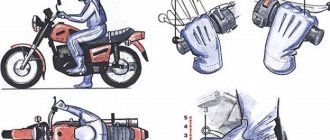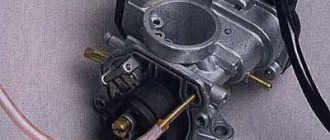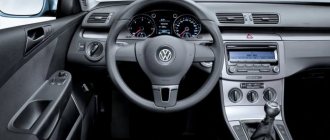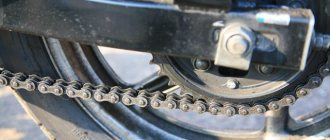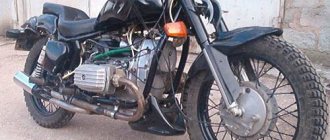22.05.2017
Diagnosing the condition of a motorcycle is undoubtedly a necessary procedure, which, in principle, should be carried out before each trip. This is what is written in the traffic rules, this is what should be done in practice, and everyone understands this perfectly well. But few bikers are able to use computer diagnostics - this is still too rare and expensive, and besides, no one will waste so much time before each trip. Therefore, we will make do with what is available. So, what can you do to identify motorcycle diseases?
Sounds
Determining the condition of the engine by the sound of operation is a cheap and at the same time inaccurate method. Moreover, the correctness of determining the malfunction depends on, so to speak, the qualifications of the biker. Experience in operating a specific motorcycle model also plays an important role, which is why there are so many “sound specialists” of our boxers and practically no people who diagnose, for example, S&S in this way.
However, regardless of the model of motorcycle, there are basic principles that apply to everyone. If you are used to operating a healthy motorcycle, then you know well what it should sound like. Any change in sound should alert you. However, you may miss the beginning of the appearance of extraneous noises and subsequently get used to them - this is especially common during a long trip at high speeds. Therefore, if you suddenly suspect the appearance of an extraneous knock or other “music”, try to diagnose the engine in more reliable ways.
The very sound of a motorcycle operating when riding is made up of many noises: the operation of the engine itself, the gearbox, the main gear, the rotation of the wheels, the creaking of equipment and much more. For example, one of my friends almost dismantled the engine because a metal strap buckle, which he never fastened, was methodically clicking against his integral helmet at high speed under the pressure of the wind. Therefore, first of all, you need to establish the place of origin of the foreign sound - it could well be a stone in the tread that catches the wing, or a play in the speedometer mount, or any other little thing. Therefore, consistently, according to the Holmes method, discard impossible options.
If an extra sound appears while riding, stop the motorcycle and listen to its operation in neutral. If the sound disappears, then it is most likely something in the chassis or in the gearbox, so hang up the rear wheel and listen to the sound when changing gears. This way, you will be able to more accurately determine where the excess noise appears - the rear wheel, the main gear or the gearbox (and in which specific gear). If there is still no extraneous sound, then you need to carefully inspect the equipment, equipment, steering and front wheel of the motorcycle, paying special attention to the brakes.
Of course, these are just general recommendations for how to listen to a motorcycle. Separate articles will be devoted to identifying faults in various components and assemblies of a motorcycle, so we will not dwell on this now.
The gears on the Stels SB 200 motorcycle shift poorly.
You can often meet the owner of a Stels SB 200, Centurion, Motoland CBR 150, Racer Skyway 200 motorcycle who will definitely mention such a drawback of his motorcycle as poor gear shifting. Indeed, if you ride on another small-capacity Chinese motorcycle, you can feel the pleasant, precise gear shifting. But on the Stels Sb 200 you begin to suffer from this problem. In this article we will look at the main causes of this problem.
So, you can encounter poor gear shifting on the Stels SB 200 both after some time of use and on an almost new motorcycle. It should be noted that this device in itself on our motorcycle is not the best, and even with ideal operation of all parts of the mechanism, it will be a little more difficult to switch gears than on mopeds or other motorcycles (for example, Irbis VR-1). But there are also situations when switching, for example from second to third, is very problematic.
So, the first thing you need to do is make sure that the foot and rod are intact. They should not be deformed or bent. and also, should not dangle freely. Such symptoms may occur after a motorcycle crash. Therefore, if such a problem appears after a fall, check this mechanism visually.
As already mentioned, this problem can also occur on a new motorcycle. In this case, the entire mechanism should be lubricated. Even regular WD-40 will do, as it has excellent lubricating properties. A lubricated mechanism will work much better. The same applies to a used motorcycle, especially after hibernation. If you do not carry out thorough maintenance, then it is not surprising that the speeds become difficult to turn on.
If these measures do not help, and it is difficult to engage upshifts (or downshifts) while driving, then you need to pay attention to the junction of the shift mechanism and the gearbox shaft. You may need to move the mechanism one or two teeth. To do this, unscrew the tightening bolt and throw the mechanism in the desired direction. Also, sometimes bad shifting goes away after changing the oil.
These measures should be sufficient in most cases. If the problem with shifting gears on the Stels SB 200 (Racer Skyway 200) remains after all the operations, then there is a possibility that the mechanism inside the engine is to blame. This is a more serious breakdown that will require complete disassembly of the engine.
Sensors and alarms
Here the motorcycle community is tightly divided into two groups - some have them, others don’t. The presence or absence of all kinds of temperature and oil pressure sensors, fuel level indicators and the like, as well as a speedometer and tachometer, is determined not only by the design features of a particular motorcycle model, but also by the personal preferences of the motorcyclist. Thus, most cruisers and large choppers are stuffed to the brim with additional equipment, but at the same time, there is a strong belief that a real chopper should not have any devices at all. I won’t convince anyone, but I myself think that at least an oil pressure warning light never hurts - it can save you a lot of everwood or evergreen on the engine output from the wedge.
So, let's assume that the motorcycle still has temperature and oil pressure sensors. In this case, an increase in temperature can occur at high ambient temperatures or heavy loads (long climbs, traffic jams, heavy loads). In any other case, it is necessary to immediately investigate the reasons for the increase in temperature - they are usually associated with clogging of the cylinder fins with dirt (for air-cooled engines), or with a coolant leak or contamination of the radiator (for water-cooled engines). However, an increase in temperature can also occur due to problems with the carburetor, ignition, exhaust system, or simply a sensor malfunction.
Oil consumption
An increase in oil consumption is one of the most reliable methods for determining that there is “something wrong” with the engine. True, there are some nuances here too. First, you need to know the normal oil consumption of a fully functional engine. Of course, this information can be found in the motorcycle passport, but the actual oil consumption of a working motorcycle may vary. This depends not only on the engine, but also on the changes made to it, the oil used, the ambient temperature, and so on. If you know how much a healthy engine of your particular bike “eats,” then you have a starting figure against which you can measure the increase in oil consumption.
By the way, it is the oil itself that has a very large influence on consumption, so it is not surprising if, when switching to another brand of oil, consumption indicators floated in one direction or another. Let’s say that expensive synthetics or most semi-synthetics have too much fluidity and do not “hold on” well in domestic economic councils, moreover, given the fact that even practically tar can flow out of them. Therefore, it is better to adhere to the factory recommendations for the oil used and, after you have found exactly the oil that will satisfy you, try to stick to this brand. In general, I will write a detailed article specifically on oils in the near future and from it you can learn about this topic in more detail.
However, we will return to the expense. An increase in oil consumption primarily indicates the presence of malfunctions in the engine. This may be a loss of tightness, wear or destruction of piston rings, or development of the cylinder walls. In any case, if you notice a sharp increase in the engine’s appetite, I strongly recommend that you subject the engine’s condition to closer examination.
Fuel consumption
In the case of increased fuel, the situation, on the contrary, most likely is not a problem with the engine. Most often, the reasons for increased gasoline consumption are friction in the brakes (check the clearances), dirty air filter, insufficient tire pressure, the appearance of additional canopy (trunks, bags, fairings) and the like. It is also worth making sure that the carburetor is adjusted correctly. Thus, a change in fuel consumption may indicate problems in completely unrelated components of the motorcycle. Therefore, I recommend installing a fuel consumption sensor (again a sensor!) or, as a last resort, periodically measuring fuel consumption at least by the frequency of filling the tank. If you suspect an increase in consumption, compare it with the predetermined normal consumption of your bike. I hope you know how fuel consumption is determined, and if you don’t know, read the operating instructions for your motorcycle.
What can happen if the scooter does not start?
If the scooter does not start in both cold and warm weather, the owner should check: the gas tank, enrichment, tap, filter, carburetor and pump. ... Due to contamination of the carburetor, problems with starting the engine may also occur. The cause of the blockage is low-quality gasoline or an ineffective filter.
Interesting materials:
What kind of fish bites at a pressure of 740? Which fish tastes better in cans? What's the fastest car in? What is the fastest car in GTA 4? Which is the longest river in the world, the Nile or the Amazon? What is the best aquarium fish? What is the best car brand? What is the very first book of Metro 2033? What is the strongest hydrohalic acid? Which chess piece cannot walk in a straight line?
Candles
The spark plugs can be used to identify most faults associated with the engine running intermittently. First of all, you need to look at the candle itself. If there is an oily black soot on the spark plug, then this problem most often indicates either oil getting into the combustion chamber (check the rings and compression), or poor fuel quality. The latter is now becoming less and less common - gasoline kings are fighting for their reputation. Wet contacts indicate incomplete combustion of gasoline, and this can also happen if fuel is stored for a long time, when it “stratifies” and heavier components reach the combustion chamber earlier than lighter ones. If the spark plug has red dry carbon, then the mixture entering the cylinder is too lean and the carburetor needs to be adjusted. If a spark “wanders” around the spark plug or a discharge breaks through the insulator, the spark plug should be replaced - it is faulty. If the spark itself is “half-dead,” then you need to look for the reasons in the ignition and wiring.
Compression
There are two types of engine compression testing: regular compression testing and the engine's ability to hold it. Both of these tests can tell you a lot about the health of the engine.
A simple compression test using an inexpensive tester measures the pressure created in the cylinder when the starter cranks. The obtained value is compared with the figures given in the operating instructions. If the compression is too weak, this indicates serious problems, for example, destruction of the piston rings or scratches on the cylinder bore. If the compression is very high, then you are very lucky (just kidding). Most likely, you installed oversized rings or pistons, filled in too thick oil, or your compression gauge is acting up.
Measuring an engine's ability to maintain compression requires an external compressor. This is a more expensive way to study the condition of the engine, but it provides greater opportunities for identifying faults. In principle, the diagnostic mechanism is quite simple: you create pressure in the cylinder using a compressor and monitor the pressure gauge readings. You can scroll the crankshaft, changing the position of the piston and thereby determining the places on the cylinder where compression drops - this indicates that
om that in these places there are defects in the cylinder walls. After this, you can begin to identify other weak points. Using a stethoscope, listen to the engine for air leaks from the cylinder. If air leaks into the exhaust system, this indicates incomplete closure of the exhaust valves; if air leaks into the carburetor, this indicates incomplete closure of the intake valves. Air leakage into the crankcase indicates a loose fit of the rings or defects on the cylinder bore (check the readings and air passage in different positions of the piston, as mentioned above).
Compression in gasoline and diesel engines, compression ratio
People who study the design of vehicles equipped with an internal combustion engine often encounter concepts and terms that are incomprehensible to the average person.
The operation of a power plant is associated with a number of physical processes, and the internal combustion engine itself is replete with all kinds of symbols. The topic of our conversation today will be the concept of compression in the engine. Let's talk about what it is, and whether there is a difference in the compression of gasoline and diesel engines.
Compression and compression ratio
The concept of compression means an indicator of the maximum pressure inside the cylinder, the pressure created at the top point of the piston (the so-called “dead center”). Compression is measured in the following quantities:
- In Pascals (1 Ra = 1H per sq.m).
- In millimeters of mercury.
- In physical atmospheres, which corresponds to 360 mmHg.
- In technical atmospheres, which corresponds to 1 kgf/sq.cm.
- In bars.
When it comes to auto mechanics, compression is usually measured in atmospheres, less often in micropascals (abbreviated MPa).
Compression in engine cylinders is a compression of gas that occurs under the influence of an external force in order to reduce the volume of gas, increase pressure and temperature.
To understand this phenomenon in detail, it is necessary to understand the structure of the motor, consisting of a valve, cylinder block, pistons and piston rings, crankshaft and connecting rods.
When the piston rises on the compression stroke, the valves are in the closed position. The fuel mixture ignites, and the pressure in the cylinder is at its maximum. The number reflecting the pressure indicator at this point in time is compression.
There are often cases when compression as a concept from physics is confused with the compression ratio, which is a mathematical value and reflects the ratio of the volume of the combustion chamber to the total volume of the cylinder. It, that is, the compression ratio, is measured as a fraction, for example, 1:12 or 1:20, etc.
As a rule, compression and compression ratio in internal combustion engines are the same, but there are exceptions, so it is impossible to talk about the identity of these concepts. The performance in turbocharged and forced power plants differs significantly.
Compression values in gasoline and diesel engines
Speaking about what compression should be in the engine, it is important to note that this value depends on what kind of engine we are talking about. The compression of a diesel engine can range from 14 to 18 and this will be the norm, while the compression of a gasoline engine ranges from 8 to 12.
But if we talk about the compression ratio, then on diesel units it cannot fall below 20:1; in the case of gasoline engines, the norm is considered to be in the range of 10:1 - 13:1.
Compression is influenced by many factors, in particular, the tightness of the connection between cylinders and pistons, cylinders and throttle valve, cylinders and valves. Novice car enthusiasts are concerned with the question of why they need to check engine compression.
The answer is simple: this is an indirect sign of a malfunction of the power plant, which may indicate the presence of serious problems in its operation. If you miss the moment, serious consequences are possible, including the need for a major overhaul of the internal combustion engine. Compression is measured using special devices - compression meters.
Causes of compression loss
If the values obtained as a result of measurements are below normal, it is necessary to restore the required pressure in the cylinders. Otherwise, the problem will worsen and operation of the vehicle will be impossible.
The engine will stop starting, its speed will begin to “jump” during operation, and extraneous noise will appear. The power of the power plant will noticeably decrease, fuel consumption will increase, and the content of harmful impurities in the exhaust gases will increase. By the way, one of the main signs of low compression is blue smoke from the exhaust pipe that appears when the engine starts.
The most common causes of compression loss include:
- A burnt-out piston, valve or gasket on the cylinder block.
- The cylinder parts are noticeably worn and require replacement.
- The valve seat has collapsed.
The first thing to do if any of the signs described above is detected is to immediately go to a service station, take measurements and diagnose. If the preliminary “diagnosis” is confirmed, it is necessary to replace the faulty components and measure the compression again.
How to measure compression
Above we talked about what engine compression is considered normal. Now we will give some tips on how to independently carry out the relevant measurements.
Let us remind you that professional mechanics measure this value using a special device - a compression meter, which is easy to find on the open market. So, “armed” with the mentioned device, which is actually a regular pressure gauge with a check valve, we do the following:
We check the battery charge, because while measurements are being taken, the engine is running on the battery. We warm up the engine in advance so that it reaches operating temperature (this is the only way to get the most accurate result).
The measurement process itself consists of the following stages:
- Removing wires from all spark plugs.
- Unscrewing the spark plug on each cylinder.
- Pulling out the fuel pump if it is electric. (In cases with a conventional fuel pump, it is necessary to remove the hose that supplies fuel from it).
- Disconnecting the electrical wire from the injectors.
You can start measuring. It is best to do this with an assistant, because one person must rotate the engine, and the second must record the results. In order for the measurements to be correct, the compression meter must be connected to the cylinder that is being checked at a specific point in time.
Next, the accelerator pedal must be pressed to the maximum - this will ensure full opening of the throttle valve. The ignition key is turned and the starter begins to rotate. You need to act until the values recorded by the device stop increasing, they become the real compression of the engine.
Upon completion of the measurements, the obtained indicators must be compared with the norm (it is indicated in the vehicle operating instructions). If the numbers are the same, or they differ insignificantly, the cause of the malfunction lies in something else.
How to restore compression
If the compression is low, the most common cause is a loss of seal, and in this situation it is important to determine where the leak occurred. To do this, about 50 ml is poured into the cylinder on which suspicion has fallen. oil and measure again. If the data remains the same, it means that the air is coming out higher, possibly in the combustion chamber. If the result is different, the cause of the malfunction lies in stuck piston rings.
If there are noticeable differences between the existing value and the one that is the norm for a particular motor, major repairs cannot be avoided. If the difference is small, the compression is increased with special additives. If they helped, great; if not, you’ll have to entrust the car to experienced mechanics.
It is noteworthy that much depends on whether the pressure has dropped in one or all cylinders at once. In the first case, you can do without repairs, and just clean the combustion chamber of deposits. When compression has dropped in all cylinders, the car is on its way to the service station.
Conclusion
Although the concept of compression itself seems complex, it is actually about the pressure in the cylinders of an internal combustion engine.
This indicator must be monitored by periodically taking appropriate measurements. It is advisable to carry out measurements even at the slightest suspicion of a malfunction - this will allow you to detect the problem in a timely manner and eliminate it with a minimum of effort.
